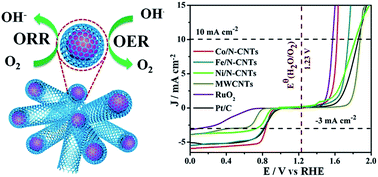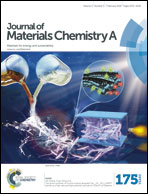Transition metals (Fe, Co, and Ni) encapsulated in nitrogen-doped carbon nanotubes as bi-functional catalysts for oxygen electrode reactions†
Abstract
The development of efficient and cheap bifunctional oxygen electrocatalysts for the oxygen reduction reaction (ORR) and oxygen evolution reaction (OER) to be applied in rechargeable metal–air batteries and unitized generative fuel cells (URFCs) operated with alkaline electrolytes is highly crucial and challenging. Here we report high-performance bifunctional electrocatalysts of transition metal nanoparticles encapsulated in nitrogen-doped carbon nanotubes (M/N-CNTs, M = Fe, Co, and Ni). The optimized Co/N-CNT hybrid shows the highest efficient bifunctional catalytic activity and excellent stability towards both the ORR and OER. The oxygen electrode activity parameter ΔE (the criteria for judging the overall catalytic activity of bifunctional electrocatalysts) value for Co/N-CNTs is 0.78 V, which surpasses those of Pt/C and RuO2 catalysts and most of the non-precious metal based bifunctional electrocatalysts reported in the previous literature studies. Furthermore, excellent long-term catalytic durability holds great promise in fields of renewable energy applications.

- This article is part of the themed collections: 2016 Journal of Materials Chemistry A HOT Papers and 2016 Journal of Materials Chemistry A Most Accessed Manuscripts

 Please wait while we load your content...
Please wait while we load your content...